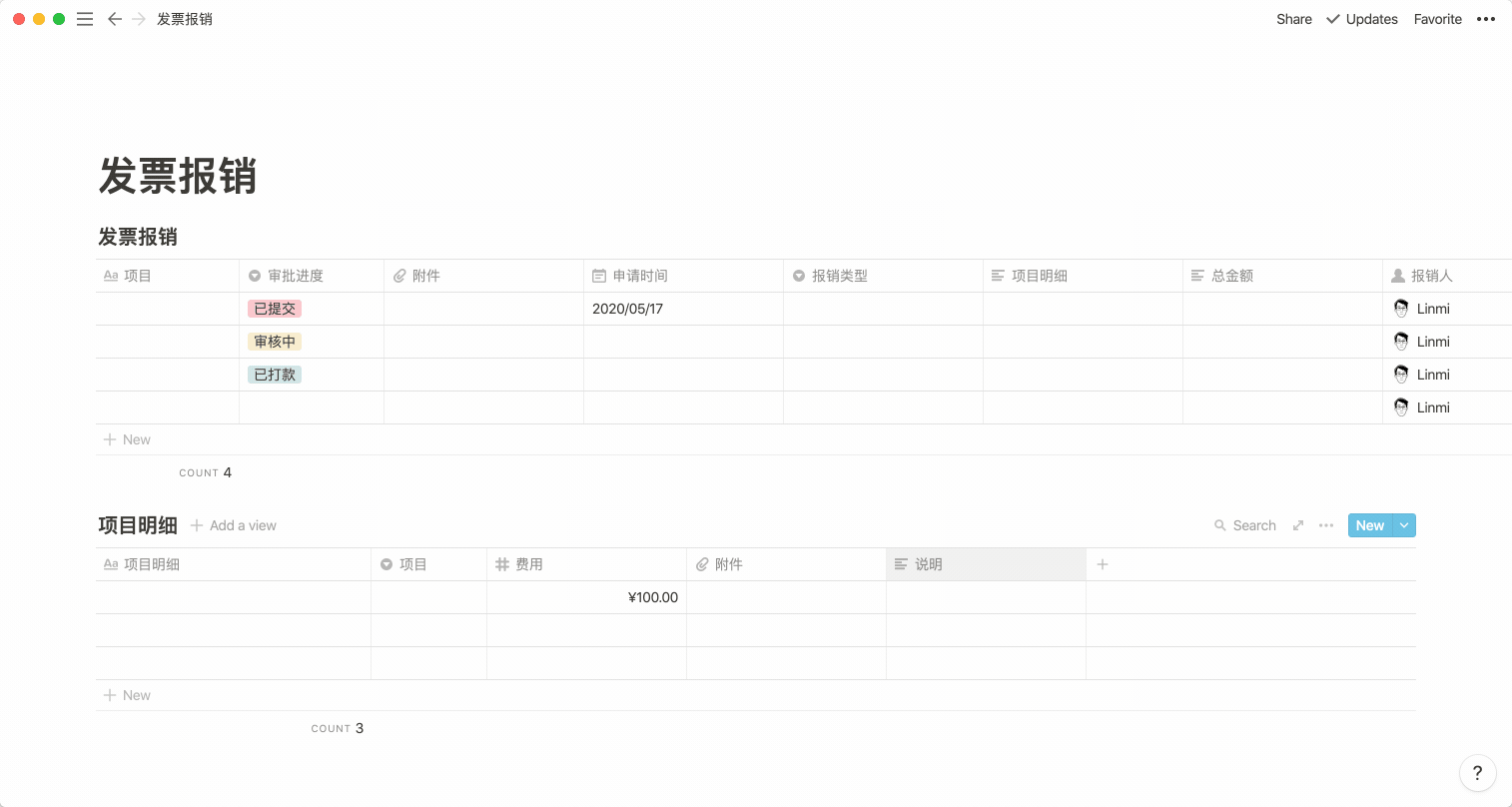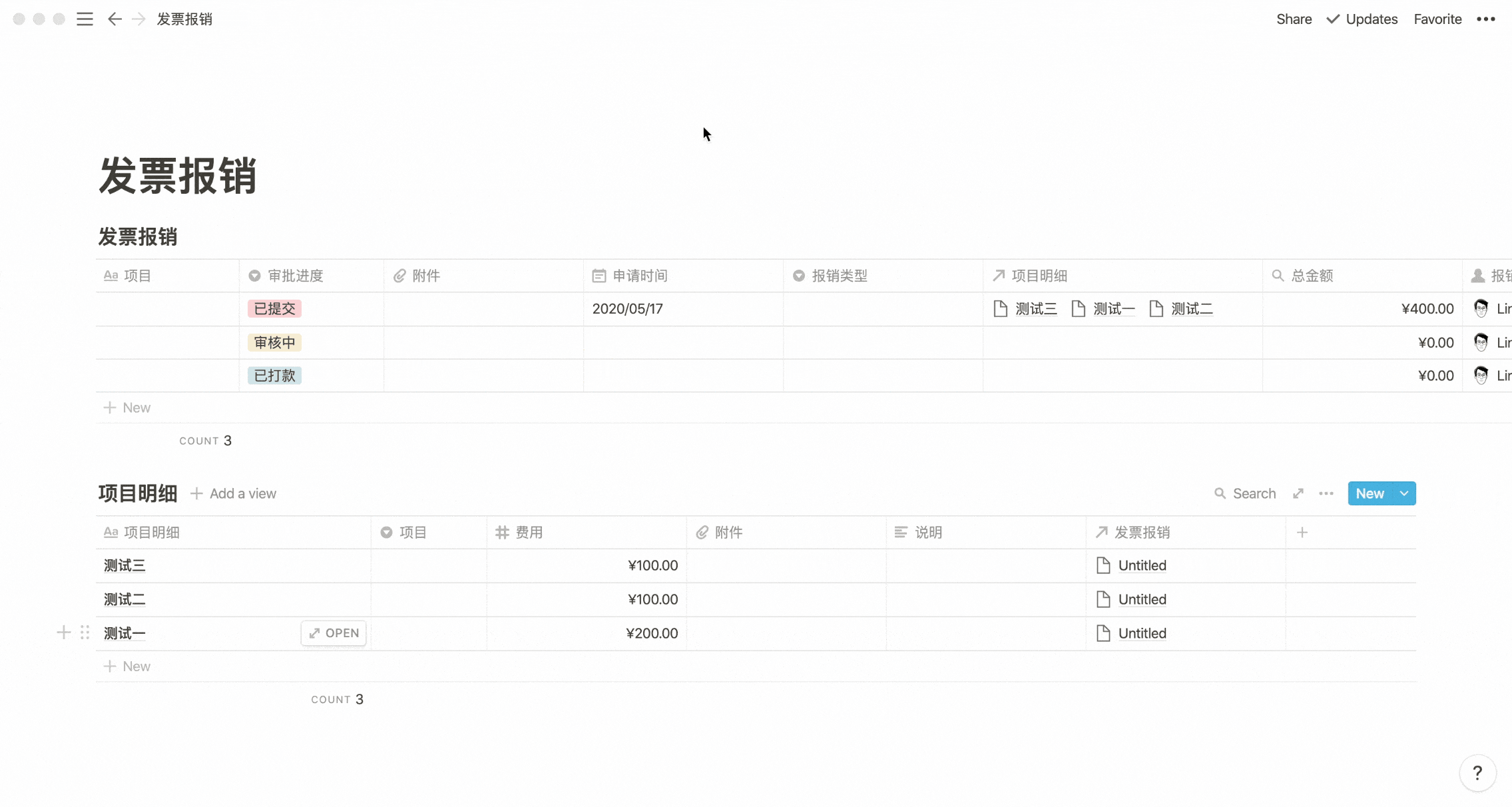Original link: https://linmi.cc/10867.html
Invoice reimbursement is not unfamiliar to people in the workplace. I have organized more than a dozen offline activities. It is quite uncomfortable when invoice reimbursement is required. It is necessary to post invoices and write details to facilitate financial verification and payment. At that time, I didn’t think in the direction of finance. If I was a finance, how would I manage these invoices?
Invoice reimbursement is not unfamiliar to people in the workplace. I have organized more than a dozen offline activities. It is quite uncomfortable when invoice reimbursement is required. It is necessary to post invoices and write details to facilitate financial verification and payment. At that time, I didn’t think in the direction of finance. If I was a finance, how would I manage these invoices?
That is today’s topic, Notion Invoice Reimbursement Template Analysis. There are two reasons for choosing this theme. First, Windy from the Notion Chinese community talked about how to manage and reimburse invoices with Notion in the online chat last night. The second is that Notion updated an automatic Filter function the day before yesterday, which can just be combined with this case to talk about.
However, it should be noted that I am not an accountant or financial officer. I read the products of related SaaS companies last night and learned that invoice reimbursement is actually very complicated. For example, it is necessary to check whether the invoice is repeated. If you are the finance of a medium and large company, it is recommended to use SaaS products directly to reduce stress. If it’s just a small team of less than ten people, try Notion to manage your organization. Of course it can be used by individuals, no need to go around in Excel.
Summary of prerequisites
- Help familiarize yourself with the basic operations of Notion Page, expand full page, view history, and embed PDF;
- It can help you understand some basic functions of Notion Datebase, such as new properties, Filter usage, Relation and Rollup operations;
- Understand the operation steps of Notion’s recently updated automatic filtering to reduce manual operation time;
The content originally involved capitalizing the amount, but I tried to implement it. It was quite complicated, so it was not included in the content of this article. Not much to say, just get started with the organization.
Tutorial Statement
Considering that Notion supports multi-terminal use, I am using the Mac version. If there are shortcut keys and other operations, Win users should replace Cmd with Ctrl and Option with Alt .
This tutorial is a semi-finished tutorial, and more details are not pointed out and explained one by one.
Effect demonstration

Organization Invoice Reimbursement Database
Before organizing the invoice reimbursement Database, we need to know what is required for invoice reimbursement. I extracted the following points from the invoice reimbursement module in the enterprise WeChat:
- Reimbursement company: If there are multiple companies in the company, for example, some companies are split into two entities in order to facilitate financing;
- Type of reimbursement: basically travel, transportation and entertainment;
- Reimbursement reason: that is, the reason for reimbursement, such as reimbursement for the expenses incurred by organizing an offline event;
- Types of fees: more, divided into air tickets, train tickets, taxi tickets, accommodation fees, food and beverage fees, etc.;
- Occurrence time: consumption time, can be specific to the hour according to the time on the invoice, depending on the individual;
- Expense amount: is the money spent;
- Explanation of expenses: For example, why does this fee exceed the budget?
- Attachments: Invoice photos, itinerary photos
- Reimbursement Persons: Half of the reimbursement individuals are individuals.
Two modules can be extracted here. The first one is the item of invoice reimbursement. The item is the main item of reimbursement, such as a team building activity. The second is the project details, which can be understood as the expenses of travel, accommodation, catering and other items under the team building activities. Through the relational database function of Notion, an association is made between the main item and the item details. And the amount of item details can also be aggregated to the main item in real time.
After understanding the main points, we can start trying to organize our management reimbursement Database.
New Database: Organize a basic invoice reimbursement framework
Steps:
- Create a new empty Page and select Empty;
- In the newly created Page, use
/Tableto create two new Tables named: Invoice Reimbursement and Item Details ;
Use shortcut keys:
- For the new Page in the above operation step 1, Mac users can use
Cmd + Nto create a new Page in the client; - Step 2: After creating a new Table, you can hold down
Option, click⋮⋮in front of Block, and drag and drop to copy.
Operation demonstration:

Modify the Invoice Reimbursement Datebase property
Steps:
- Expand the newly created invoice reimbursement page, click on the upper right corner
···, find theFull widthoption and turn it on; - Click the Name option in the Invoice Reimbursement Database to start modifying the properties one by one.
- Project: Name attribute, that is, the above-mentioned group building and offline activity organization, which is similar to the collection of some expenses;
- Approval progress: Select attribute, which is represented by three kinds of progress, namely submitted, under review, and paid;
- Application time: Date attribute, the time to fill in the form, and End Date can be used to indicate the time of payment;
- Reimbursement type: Select attribute, similar to team building, party, office supplies purchase;
- Total Amount: Default Text, which needs to be modified later, here is the amount used to calculate the item details;
- Project details: Default Text, which will be related to the project details later;
- Attachment: Media & File properties, upload screenshots of invoices and itineraries, mainly for centralized expenses;
- Reimbursement person: People attribute, if you consider yourself to be reimbursed, you can choose
Create By.
Operation demonstration:

Modify the Invoice Reimbursement Datebase property
- Click on the item details to modify the properties respectively
- Project details: Name attribute, corresponding to the expenses of travel, accommodation and other items in the team building;
- Items: Select Properties, Travel, Transportation and Hospitality;
- Type: Select attribute, air ticket, train ticket, taxi ticket, accommodation fee, meal fee, etc.;
- Fee: Number property, after selecting, click
123before the number to select Yuan; - Reimbursement items: will be automatically generated after Relation;
- Attachment: Media & File attribute, upload the screenshot of the invoice and the screenshot of the itinerary, which can be displayed separately;
- Description: Text property that explains something beyond the scope of reimbursement.
Operation demonstration:

Then we fill in some data in the attribute according to the requirements, such as the data of the Select attribute, and the display style of the modification time.
Modify the Select property

Modification time display style
Here I changed the time to year, month, and day, which is more in line with the habits of Chinese people.

Invoice reimbursement is associated with item detail Database
Steps:
- In the item details column in the invoice reimbursement , we modify the attribute to Relation, and then retrieve the item details Datebase for association;
- Modify the property name just associated with the item details and change it to invoice reimbursement ;
Operation demonstration:

Calculate the total amount
After the Relation association, we need to calculate the total amount of the item details, and here we need to use Rollup.
Steps:
- Change the total amount property to Rollup;
- Click the input box to select the item details, cost and Sum respectively;
- Test total data.

Set up automatic correlation filtering
Steps:
- Follow the steps above to create a Datebase and associate two Datebases;
- Click ⋮⋮ in front of the project details
⋮⋮, and copy the link of this Datebase; - Click ﹀ next to
Newin the upper right corner of the project details﹀, and then click+ New template; - Paste the link of the project details , adjust the attribute position, and it is easier to view and use after the template is generated;
- Name the template as reimbursement template , click on the item details
···above, click and find the Filter operation button; - Select the attribute as invoice reimbursement , and select Contains as the reimbursement template just named;
In this way, our automatic filtering template is realized. After that, we only need to click on the reimbursement template, and the content created in the template will be automatically associated without manual operation.
Operation demonstration:

data filling test
We randomly fill in some data for testing and see some content effects. In fact, the Gif is demonstrated.

management evolution
The template is basically enough to meet the summary reimbursement of a small team of ten people. If it is extended to more people, it is necessary to constrain team members in advance to avoid audit pressure on finance, such as duplicate invoices, which are difficult to automatically determine in Notion.
Similarly, this article does not introduce View creation. Through View creation, you can classify and filter data in different states and get the data you want. The content will be supplemented after the video is recorded.
Summarize
In fact, this management invoice can also be used to manage documents and tasks, but the essence is only different in attributes. Another scenario is to manage express mailing information + record the storage data of items, and add a Tel and Checkbox to the attributes.
template acquisition
This article is reprinted from: https://linmi.cc/10867.html
This site is for inclusion only, and the copyright belongs to the original author.